By Wayne Lincourt
https://www.centuryarms.com/
https://www.texasweaponsystems.com/
https://www.damageindustriesllc.com/
If you like to shoot like I do, you’re faced with limited supplies of ammo and high costs (when you can find it). You can’t always reload either, because the most common powders are just not available. I’ve been looking for reloading powder online and at the local sporting goods stores for more than a month. Got everything else, but no powder to send the bullet on its way.
However, there is one rifle cartridge that’s in plentiful supply at very reasonable prices—7.62×39. Developed by the Soviets during WW II, it later became the cartridge of the battle rifle developed by Makhail Timofeyevich Kalashnikov. Introduced as the Avtomat Kalashnikova model 1947, better known as AK-47, the gun was adopted by the Soviet Armed Forces in 1949 and has since proven itself in 65 years of continuous service in militaries around the world.
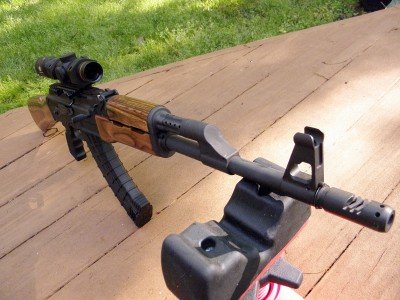
You can see the gas tube, which actuates the bolt carrier group, on top of the C39 just forward of the hand guard.
The popularity of the low-cost 7.62×39 round has not escaped the attention of AR-15 manufacturers, and there are now a number of really nice ARs chambered in 7.62×39. The problem is that to buy one you have to pay AR prices (unless you build your own). Century Arms, long an importer of surplus foreign-made AKs, has developed its own brand new AK-47, the C39 Classic, made in its Vermont factory and sold for less than half the price of an AR. As an aside, this is not intended as an argument in favor of the AK platform versus the AR. The AR is a newer, more refined and versatile design. This is strictly about the practical economics of shooting on a budget in today’s firearms/ammunition environment.
Up to this point, you were limited to military surplus AK-47s. The problem is in finding one that’s not, to use the scientific term, junk! Some perform reasonably well, some don’t function well at all, and accuracy is quite literally, hit or miss. AKs went from milled receivers to stamped receivers in 1963 to reduce manufacturing costs, and that’s what you’ll find in most imported guns. These military surplus (used) guns can be found for around $400 depending on model and condition. Of course, government restrictions on importing certain guns, like the AK-47, led to American-made parts to make them legal. You see, you can still sell them as long as they are made with no more than ten imported parts (Title 18 Chapter 44 Section 922(r) of the United States Code). That’s where the term “922r compliant” comes from. These restrictions resulted in additional parts being produced in the US until we had almost enough to build an entire gun. Century International closed the loop a couple years ago and started manufacturing completely new US-made AK-47s dubbed the C39 Rifle. The receivers of the Century International Arms guns are machined from solid steel for better accuracy and repeatability. The rest of the parts are pretty standard AK parts.
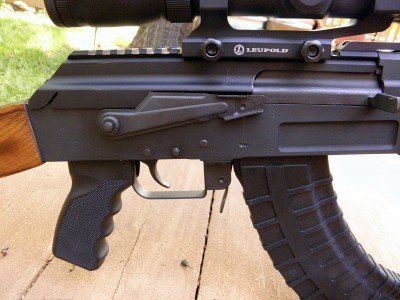
The big lever above the trigger is the clunky AK-47 safety. It was very tight at first, but the more it’s used, the easier it gets to manipulate. The lever sticking down between the trigger guard and the magazine is the clunky AK-47 mag release.
The Century International C39 Classic Rifle is faithful to the Kalashnikov design, which has proven to be rugged, dependable and easy to maintain. The AK is a simple design wherein a gas port on top of the barrel actuates a piston which in turn cycles the action. The fact that the gas drives a rod to cycle the bolt carrier group means that the top end of the rifle stays cleaner than a direct impingement systems, where the gasses act directly on the bolt. All parts are readily accessible simply by removing the dust cover and extracting the recoil spring/gas rod and bolt carrier assembly. The handguard/gas tube assembly is easily removed by first turning a small lever that releases the pressure holding it in place. Another lever allows removal of the forend.
That’s as far as you have to go to strip the gun unless you want to replace the stock. The stock is a little more difficult to remove due to the press fit, but it’s not that bad with the right tools. The C39, by-the-way, uses a Polish-style stock attachment that secures the stock with a lower tang as well as an upper tang extending back from the receiver. This is a more solid attachment but limits aftermarket stock selections. There are two departures from the original AK. The rear leaf sight is adjustable for both windage and elevation instead of just elevation, and the stock is one inch longer than military issue. They are both good changes.
As you can see in the photos, Century has installed nice laminated wood furniture that retains the classic look of the AK while providing greater stability than solid wood. The wood is available in three colors – black, brown or blonde. The test gun obviously has the brown wood. It’s also available with composite furniture for a slightly higher price, and there’s a chrome-lined barrel option as well.
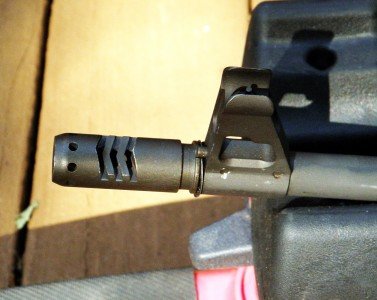
The flash suppressor/muzzle brake is a Century exclusive. It’s held in place by a spring-loaded button on the front of the sight base. I added a stainless steel wave lock washer to hold it more rigidly. That will be replaced with a set of thin washers that will allow tightening the muzzle brake completely.
The only concern I had before going to the range was that the flash suppressor/muzzle brake had some free movement. It screws down almost tight and is held in position, with the ports directed up to reduce muzzle rise, by a spring loaded plunger. However, because it wasn’t seated firmly, the suppressor could be wiggled a little with your fingers. I solved the problem with a stainless steel wave lock washer from Ace Hardware, which I placed between the suppressor and the front sight mount to take up the slack. It probably wasn’t necessary, but I figured it couldn’t hurt.
On my first range session, I found that the C39 is a fun gun to shoot. Magazines are easy to load simply by pushing the rounds straight down from the top of the mag, and recoil is moderate, meaning that after 220 rounds I could have kept shooting. It doesn’t beat you up the way that some rifles do. By-the-way, the C39 comes with two 30-round Tapco USA composite magazines in the familiar and somewhat sinister banana shape. Although the gun may look bad with the 30-round mag, I found the Tapco 5-round and 10-round magazines to be more practical for range work. For hunting most game, the 10-round mag would provide plenty of firepower as well. The 30-rounders would be fun to burn through ammo with a Slide Fire bump stock, but commercial ranges limit fire to no more than one round per second. Bummer.
Using the stock iron sights, the gun was reasonably accurate. At 50 yards, I shot some one-inch three-shot groups, although my five-shot groups always opened to three inches or so. At 100 yards, my five-shot groups averaged around six inches, which is good for me using iron sights.
I wanted to mount an optic, though, to get a better idea of the gun’s real accuracy potential. One of the inherent problems with the AK, unfortunately, is mounting an optic. The loosely mounted dust cover on the top of the receiver doesn’t offer a suitably stable surface to attach a scope. Some AK versions have provisions to add a mount to the left side of the receiver. The side mount arches over the dust cover, detracting from the clean lines of the gun, and has to be high enough to permit opening the dust cover, just barely. This puts the optic higher than optimum for achieving a good cheek weld on the stock.
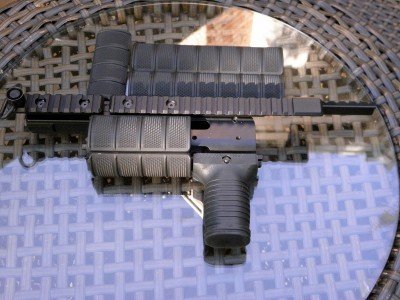
Damage Industries makes some nice accessories for the AK-47, including this forend/handguard/gas tube. It also makes parts to accessorize the accessories, like the sling swivel and handguards that snap onto the rails.
There are several solutions available in the aftermarket. Some require drilling holes in the receiver, a process I wanted to avoid. Damage Industries has a nice forend/handguard/gas tube replacement made from anodized aluminum. It’s well made and provides a host of mounting options including long and short Picatinny rails, sling swivels and rail covers in all the popular colors. It was a very tight fit. Unfortunately, as much as I liked the forend/handguard, I had problems with the red dot mount, which extends back from the side of the forend. It’s actually an extended Picatinny rail that makes a couple of 90-degree bends to bring it on top of the dust cover behind the leaf rear sight. This leaves the optic mounted on an extended (7 ½” unsupported) length of aluminum that has some flexibility. There’s a screw which supports it at the rear by resting on the dustcover. However, I just couldn’t keep the sight zeroed and finally gave up on it.
There are rails that mount directly to the dust cover, but the stock cover just isn’t stable enough to work. I then came across a variation on this from a company in Austin, Texas, not too far from me—Texas Weapons Systems (TWS). It is called a Dogleg Rail, but it’s really a replacement dustcover with the rail built in. The “dogleg” portion of the name comes from a component that replaces the leaf sight, being pinned solidly to the top of the receiver. This is held under considerable pressure from the leaf sight flat spring. It then bolts directly to the TWS dustcover, anchoring it securely at the front. Also included is a replacement dust cover retaining button. The bottom of this button is cut with a bevel or wedge shape that puts downward pressure on the back of the dustcover. Through mechanical advantage, it effectively triples the force of the recoil spring as it converts it to clamping force to hold the dustcover solidly in position. There are some further modifications to the bottom skirt of the dustcover for added stability. The TMS mount is a full-length rail permitting the use of a scope instead of simply a red dot, or if you wanted a red dot, you could also add a magnifier behind it.
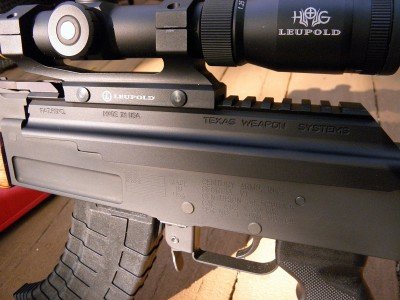
The Texas Weapon Systems’ rail proved to be a solid scope mount for getting the most from this surprisingly accurate gun.
I mounted a Leupold VX-R HOG 1.25-4×20 variable power illuminated reticle scope. The reticle is one Leupold calls the FireDot Pig Plex. You don’t really need the illuminated center red dot, but it does make target acquisition faster in a hunting situation where you want to get a shot off quickly. The combination of the Texas Weapons Systems Dogleg and the Leupold VX-R was just what I was looking for. After zeroing at 50 yards, I went to the 100-yard target and was able to quickly fine-tune the zero. Amazingly, the Century C39 shot to 1 minute-of-angle accuracy. That’s all shots into one inch at 100 yards with cheap Russian made ammo! Given the AK’s reputation for poor accuracy, it was much better than I expected and certainly plenty of accuracy for hunting or home defense.
I used some of the most readily available ammo from Wolf and Silver Bear. More specifically, 123 grain jacketed hollow point Wolf ammunition from Ukraine, and two types of Silver Bear from Russia – 123 grain jacketed hollow point and 123 grain semi-jacketed lead soft point. (These are all steel cased rounds so you can’t reload them.) The Silver Bear hollow points consistently performed the best. They also had the highest muzzle velocity and the least deviation in velocity from round to round. The Wolf hollow points were the second best for accuracy, although they had the lowest muzzle velocity. Out of a total of 350 rounds of a mix of ammo, there was only one malfunction—a failure to extract with the Wolf ammo. The Silver Bear soft points had the second highest average muzzle velocity but the greatest deviation in velocity shot-to-shot and the poorest accuracy.
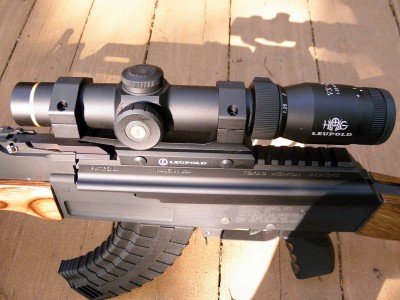
The Leupold 1.25-4x20mm VX-R HOG illuminated scope was the perfect match for the capabilities of the C39. Doesn’t look too bad on it either.
MSRP for the C39 is $799.99. Street prices seem to be running around $600-640. The ammunition cost less than twenty-five cents a round buying in bulk—240-500 round lots.
As I said, it’s a fun gun to shoot, doesn’t break the bank, and I like the look of wood on a gun. If you want to make it your own, there are lots of aftermarket products to customize it. The only problem I’ve run into is finding a fully adjustable folding stock. Most aftermarket stocks are designed for stamped receivers, and I haven’t yet learned if it’s possible to modify one to work with the C39.
The Leupold VX-R HOG is a good match. Because the leaf sight base is higher than the top of the dust cover, you’d have to use high rings if your scope had much of a bell on the objective end. It’s best to have scopes mounted as close to the bore axis as is practical. Mounted on a one-piece Leupold forward cant set of rings, it clamped easily to the Picatinny rail. I took it off during my range session to check the screws of the TWS rail and it went back to zero when I reinstalled it. As in any scope mount, you should use blue Loctite on all the screws. Same with the TWS rail. There were no problems with screws shooting loose on either.
The illumination button is on the left side of the scope. One press turns it on and each additional press takes it to the next brightness level. Hold it in and the dot turns off. The next time you turn it on, it illuminates at the last setting. The optics are bright and clear, edge-to-edge. The 4-power max magnification was plenty for 100 yards and should allow you to place accurate shots out much farther. I especially liked that you didn’t need a screwdriver to adjust windage and elevation. Eye relief for me was about 3 ½”, which gave me a full field of view through the scope with everything in sharp focus. The only thing I’d add to the scope would be a good set of flip-up lens caps to protect the glass. The 1.25 setting is good for close in or moving targets. In fact, with the dot illuminated, you could use any magnification setting with both eyes open. Where you see the dot is where you’re aiming. Just ignore the magnified image.
Although you could potentially take game out to 300 yards, I’d personally use the AK for shots out to 200 yards. The Leupold should be all the scope you’d need for that. MSRP is $624.99. As usual, street prices are considerably less. I’ve seen it advertised for around $500.
Century C39 Ballistics:
Ammunition Mean Velocity Standard Deviation Extreme Spread Muzzle Energy Smallest Group Size*
Silver Bear 123gr JHP 2461.6 fps 7.36 fps 38 fps 1655 ft. lbs. 0.75”
Silver Bear 123gr SP 2446.8 fps 12.96 fps 86 fps 1635 ft. lbs. 2.80”
Wolf 123gr JHP 2321.2 fps 8.32 fps 41 fps 1471 ft. lbs. 1.58”
*Five shot groups fired from a rest at 100 yards.
- At a little over eight pounds and firing the 7.62×39 loads, recoil is not a problem.
- The 30 round Tapco USA magazine is standard. The scope and dust cover with Picatinny rail are aftermarket products.
- Here’s the other side without the rails in place. The vertical grip is the short Tapco grip, which doesn’t interfere with loading the 30-round magazines into the gun. The arrow shows the red dot mounting rail with which I had some problems.
- Here’s what it looks like under the hood.
- The next parts to come out are the recoil spring, gas rod, bolt carrier and bolt. This is the action of the gun. Doesn’t get much simpler.
- Now the trigger group is exposed. This is how it looks after firing 150 rounds. Not too bad.
- This is the loaded five-round magazine about to go into the gun.
- Here’s a better angle of the flash suppressor/muzzle brake.
- The gun comes with two Tapco USA 30-round magazines. However, the 10-round and 5-round Tapco magazines were preferable for range work. They functioned reliably with no problems.
- The round mount on the left side of the scope houses the CR 2032 battery. The gold center with the Leupold “L” is the on-off button which also adjusts the illumination level.
- The Leupold 1.25-4x20mm VX-R HOG illuminated scope was the perfect match for the capabilities of the C39. Doesn’t look too bad on it either.
- The windage and elevation adjustment knobs require no tools and make zeroing the scope a quick process. One click equals ¼” at 100 yards (or ¼ minute of angle as the knob says).
- Between the scope and the receiver is the piece that gives the Dogleg mount its name. It mounts in place of the rear leaf sight, holding the front of the dust cover/rail solidly in place. You can see the D-shaped head of the pin that secures it. The lever on the side of the receiver locks the handguard in position.
- The Texas Weapon Systems’ dustcover/rail swings up well out of the way when performing maintenance.
- The bottom of the Texas Weapon System’s dustcover retaining latch is cut at a downward angle in relation to the base, which slides in a horizontal slot in the receiver. It exerts substantial downward force on the dustcover to lock the rear firmly in place.
- This was my best group at 100 yards with the Silver Bear 123 grain hollow points.
- The second group of five shots from 100 yards during zeroing. Yeah, I could have just fired two or three rounds, but with ammo this cheap, why not have some fun.
- After zeroing at 100 yards, they all stayed in the bulls-eye. Not the tightest group but not bad either.
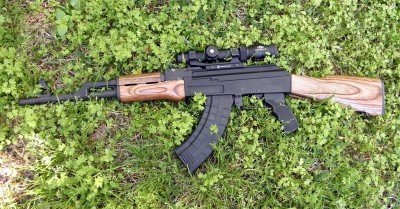
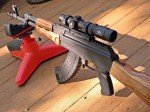
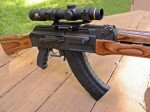

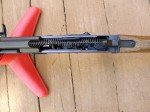

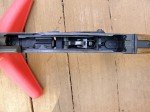
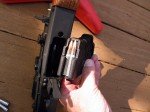
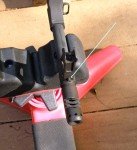
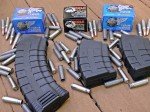
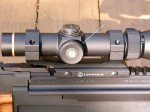
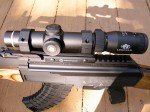
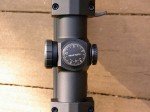
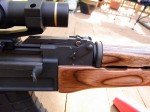
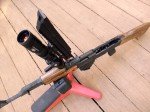
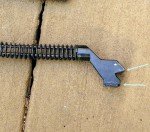
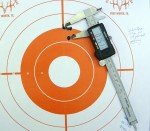
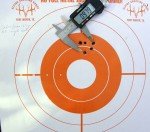
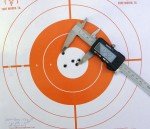
It is a U.S rifle that is made to not surpass the AR’s. All international AK’s are better. If you look at the pictures closely, you will see that metal has been knocked off the carrier & rounded off. Int. AK’s do not do that. Propaganda.
The question is, “did Century really try to make a good rifle?” If they did, they can’t produce quality. If they made the rifle to have defects on purpose, then, you could probably argue the position for diminishing. Century’s AK’s are out of specifications. Even the barrel has less rifling, furniture is junk – the absolute worst and the sights are slanted. I do not understand what they are trying to do, with the model. As far as I’m concerned, it is a cluster & int. companies are going to eat them alive. They are going to have to keep paying for import parts.
Agreed that the author seems to know very little about AKs. To anyone considering buying an AK for the first time — DO YOUR HOMEWORK FIRST! I hate to say it, but AVOID US-built Century guns like the C39 and RAS47. These guns are not holding up well under heavy use and are literally ripping themselves apart in their owners’ hands.
I have a c-39 sporter,it’s a piece of shit,bought it new at turners,only 300 rounds through it,the bolt is falling apart
Pieces of metal are pealing off the mushroomed bolt lugs,so when I called century,they said email us pictures so I did. Jason Dressler told me Oh don’t worry,mines like that too.That my friends is big bullshit,they won do anything to help me,they are a really fucked up company,now what do I do? I guess find a gunsmith to fix it it’s too scary to shoot, George
DO NOT mount a scope to a dust cover rail. Those things move around…plenty. And loose zero when you remove to clean bolt.
The writer has an excellent set up. The TWS (Gen 2) dog-leg rail cover works great and holds zero without any issues. As for a scope, his Leupold is another excellent choice. I personally prefer the Trijicon ACOG for this application. Add a Krebs safety with the index finger control/’bolt hold open’ feature, a Krebs FCG retaining plate, plus your sling of choice and call it a day. The channel built into the Trijicon mount allows for perfect alignment with the front sight to be used as BUIS if needed.
I depressed the plunger in front of sight to remove the flash supressor
it went down supressor turned 1/4 turn won’t go on and won’t come back ?? Help!!
I prefer the WASR-10, but that’s just a personal preference. I haven’t owned a C39 yet – but may have to start saving now. If you own a WASR-10 you should check out the facebook group dedicated to the Romanian version of the AK47
https://www.facebook.com/groups/261020827813/
I swear, I’m so sick of boneheads saying (The AK is not accurate). Yes it’s not a Sniper Rifle, and yes my M4 is more accurate. That said, at 100 I’m hitting about a 3-4 inch group with “CHEAP” Russian Ammo.
I don’t know about you? But that’s 30 Head Shots at 300 feet!!!!! And Leupold’s are great, but as someone else said…..On an AK????? You are way to biased.
Question: is a hinged top cover come installed with this rifle? Thank you in advance.
I get the feeling the author is not really tuned-in to the Kalashnikov world, since the fourth paragraph is riddled with a number of misconceptions.
First, military surplus AK-47s would be amazing to have in the US, considering they would definitely be machine guns. True, there are examples of transferable AK-47s in circulation, but unless the author is holding some information back, semi-auto AK-47s strike me as unlikely to see military service. More likely he means guns built from demilled AK and AKM parts kits, which are prevalent. Still, this ignores a number of long-imported, commercially-built rifles on the Kalashnikov pattern such as the ubiquitous Romanian SAR and WASR, the mythical Bulgarian SSR-85, readily restored Russian Saiga, and even a plethora of Clinton-banned Chinese Norincos.
Second, I know they’re basically the same rifle, and there are so many similarities that it could be argued that one term should be good enough for both designs, but a professional gunwriter should know the difference between an AK-47 and an AKM. This may be “clip vs magazine”-level of pedantry, but I expect more from someone getting paid to write about guns.
Third, where the heck are you finding any kind of Kalashnikov rifle for $400? Is it still the year 2007 where Guns America is located? I could accept that “junk” rifles are all that’s available at that price point, but even WASRs are still over $500. It’s too bad the author didn’t have an online classified ad he could search to find the asking prices of the rifles he was writing about. Also, I don’t want this to be interpreted as me calling WASRs “junk”. They certainly seem the most prone to being problematic, but this propensity could be magnified by their pervasive popularity. Homebrewed kit builds are, in my opinion, the most at-risk of turning out to be lemons in a very bad way.
Good shooting though.
One other misconception that everyone seems to have is that the AK47 started out as a milled receiver, this is not true. The original AK’s were stamped receivers with a smooth side from 1947 to 1951 but there were problems with the stamping process and the metal used. In 1951 they started using milled receiver to prevent the breakage and twisting problems that were being had with the stamped receivers. In 1959 with the improvements in the stamping process and newer metal technology they again went to stamped receivers with the dimple over the magazine well for strength and became the AKM that we know today.
I totally see why you would mount a scope on a carbine, it gives you better first round hit capability and better target identification than the naked eye. The USMC uses a 4x Trijiicon scope on the M4 and M16A4 for those very reasons. I hope to purchase one of these soon but I have to find if it can be owned by a New Jersey resident.
*Education
Marines whom are Forward Deployed, organize their patrols so that only the dedicated marksmen would have a Mil Dot Rectile. Due to the fact that any optic will break, and iron sights are perfect. A marksmen can use factory iron sights in any situation; more effectively, and more accurately, than with top shelf gear. This is shown by higher accuracy ratings across the board, and proportionally measured to size of other branches of the military, whom are given red dot scopes, and other variants.
-Opinion
*For people whom are getting older or suffer from vision problems, a scope or rectile is a saving grace. I myself use a rectile and have a far more pleasant shooting experience.
“With iron sights, you have to align your aiming eye perfectly with the sight axis. The eye, the rear iron sight, the front iron sight and the target must all be exactly aligned. Your aiming eye is focused on the front sight, not on the target, and the other eye is typically closed. This technique works very well, but it takes a lot of practice, it tends to fall apart under stress when it’s needed most, and it limits your view of the target and the surroundings.” I irons sights are not the be all, end all. They have limitations just the same as optics. Being able to use both tools to their advantages and understanding their limitations will make you a better marksmen. I have seen forward deployed Marine units all use optics, only real difference was the length of their rifle barrels.
These are fantastic rifles! I own two of them and have been very pleased. Be sure to check out this Facebook group dedicated to the Centurion C 39. https://www.facebook.com/#!/groups/1419288431643794/
I could never see why you would want to put a scope on a carbine. I mean if you want to hit something at a distance, why don’t you just get a full seize rifle. I mean, if that’s all you have,I get it but I’m just saying……”…